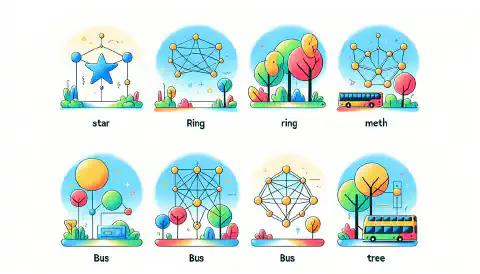Maximize Long-Distance Networking with Top Cabling Solutions

Table of Contents
Networking Over Long Distances: Understanding Cabling Types
Networking over long distances is crucial for modern communication systems. Whether it’s connecting offices in different cities or enabling communication in remote areas, understanding the different cabling types is essential. This article provides an overview of fiber optic cables, ethernet cables, wireless networking, and satellite communication, highlighting their advantages and considerations for long-distance networking.
Key Takeaways
- Fiber optic cables are the preferred choice for long-distance networking due to their high bandwidth and low signal loss.
- Ethernet cables provide reliable connectivity for long-distance networks, with different types available for specific requirements.
- Wireless networking offers flexibility and mobility for long-distance communication, but it is subject to limitations such as signal interference and range.
- Satellite communication is a viable option for extending networks to remote locations, providing coverage in areas where traditional infrastructure is unavailable.
- When setting up long-distance networks, it’s important to consider factors such as bandwidth requirements, latency, security, and scalability.
Introduction to Networking Over Long Distances
The Importance of Networking in Long-Distance Communication
Networking plays a crucial role in facilitating communication over long distances. It enables the exchange of information and data between geographically dispersed locations, allowing businesses and individuals to connect and collaborate regardless of their physical proximity.
- Networking enables seamless communication between remote offices, branches, or even different countries.
- It allows for real-time sharing of data, files, and resources, improving productivity and efficiency.
- Networking over long distances enables remote access to systems and applications, enabling employees to work from anywhere.
- It supports video conferencing and virtual meetings, reducing the need for travel and enabling face-to-face communication.
By establishing reliable and efficient networking solutions, organizations can overcome the limitations of distance and create a connected environment that fosters collaboration and growth.
Understanding the Challenges of Long-Distance Networking
Long-distance networking presents several challenges that need to be understood and addressed for successful communication. These challenges include:
- Signal Loss: As data travels over long distances, it can experience signal loss due to attenuation. This can result in degraded performance and slower transmission speeds.
- Latency: The time it takes for data to travel from one point to another increases with distance. Latency can impact real-time applications and require optimization techniques.
- Interference: Long-distance networks are susceptible to various forms of interference, such as electromagnetic interference (EMI) and radio frequency interference (RFI). These can disrupt the signal and cause data errors.
- Security: Securing data transmitted over long distances is crucial. Long-distance networks are vulnerable to eavesdropping and unauthorized access, requiring robust encryption and authentication mechanisms.
To overcome these challenges, network engineers employ various techniques and technologies, such as error correction algorithms, signal amplification, and advanced encryption protocols.
Benefits of Implementing Networking Solutions for Long Distances
Implementing networking solutions for long distances offers several benefits:
- Improved Communication: Networking solutions enable seamless communication over long distances, allowing businesses to connect with remote offices, branches, or clients.
- Cost Savings: By implementing networking solutions, businesses can reduce costs associated with traditional methods of long-distance communication, such as phone calls or travel expenses.
- Increased Efficiency: Networking solutions streamline processes and enable efficient sharing of resources, data, and information across long distances, improving productivity.
- Flexibility and Scalability: Networking solutions provide the flexibility to expand and scale the network infrastructure as the business grows, accommodating future needs.
- Enhanced Collaboration: Networking solutions facilitate collaboration among geographically dispersed teams, enabling real-time communication and collaboration on projects.
- Improved Security: Implementing networking solutions with robust security measures ensures secure transmission of data and protects sensitive information from unauthorized access.
- Reliability and Redundancy: Networking solutions offer reliable connectivity over long distances, minimizing downtime and ensuring uninterrupted communication and access to resources.
Fiber Optic Cables: The Backbone of Long-Distance Networking
How Fiber Optic Cables Transmit Data over Long Distances
Fiber optic cables are the preferred choice for transmitting data over long distances due to their unique properties.
- Fiber optic cables use light signals to transmit data, allowing for faster and more reliable communication.
- The core of a fiber optic cable is made of glass or plastic, which enables the transmission of light signals.
- The core is surrounded by a cladding layer that reflects the light signals back into the core, preventing signal loss.
- To further protect the core, fiber optic cables have an outer jacket made of durable materials.
Fiber optic cables are capable of transmitting data over extremely long distances without significant signal degradation. This makes them ideal for long-distance networking applications such as telecommunications, internet connectivity, and data centers.
Tip: When installing fiber optic cables for long-distance networking, ensure proper fiber optic cable management to maintain signal integrity and prevent damage.
In summary, fiber optic cables transmit data over long distances using light signals, providing fast and reliable communication for various applications.
Advantages of Fiber Optic Cables for Long-Distance Networking
Fiber optic cables offer several advantages for long-distance networking:
- High Bandwidth: Fiber optic cables have a much higher bandwidth compared to other types of cables, allowing for faster data transmission over long distances.
- Low Signal Loss: Fiber optic cables experience minimal signal loss over long distances, ensuring reliable and consistent data transmission.
- Immunity to Electromagnetic Interference: Unlike copper cables, fiber optic cables are not affected by electromagnetic interference, making them ideal for long-distance networking in environments with high electrical noise.
- Security: Fiber optic cables are difficult to tap into, providing a higher level of security for long-distance network communication.
In addition to these advantages, fiber optic cables are also lightweight, flexible, and can transmit data over longer distances without the need for signal boosters or repeaters.
Types of Fiber Optic Cables Used in Long-Distance Networking
Fiber optic cables are the preferred choice for long-distance networking due to their ability to transmit data over vast distances without signal degradation. These cables use light signals to carry information, allowing for faster and more reliable communication. There are several types of fiber optic cables commonly used in long-distance networking:
- Single-mode fiber: Designed for long-haul communication, single-mode fiber has a small core that allows light to travel in a straight line, minimizing signal loss. It is ideal for transmitting data over extremely long distances.
- Multimode fiber: With a larger core, multimode fiber can carry multiple light signals simultaneously. It is commonly used for shorter distances, such as within a building or campus network.
- Plenum-rated fiber: Plenum-rated fiber optic cables are designed for use in plenum spaces, which are areas in buildings used for air circulation. These cables have a special coating that reduces the risk of fire.
When choosing fiber optic cables for long-distance networking, it is important to consider factors such as the required bandwidth, distance, and environmental conditions. By selecting the appropriate type of fiber optic cable, organizations can ensure reliable and high-speed connectivity for their long-distance networks.
Ethernet Cables: Reliable Connectivity for Long-Distance Networks
The Role of Ethernet Cables in Long-Distance Networking
Ethernet cables play a crucial role in enabling long-distance networking. They provide reliable connectivity and facilitate the transmission of data over extended distances. With their high bandwidth capacity and low latency, Ethernet cables ensure efficient and seamless communication between devices in a network.
Ethernet cables are designed to support various network speeds and can handle large volumes of data transmission. They are available in different categories, such as Cat5e, Cat6, and Cat6a, each offering different performance levels. Choosing the right type of Ethernet cable is essential to ensure optimal network performance.
Here are some key considerations when selecting Ethernet cables for long-distance networks:
- Bandwidth requirements: Determine the amount of data that needs to be transmitted over the network and choose an Ethernet cable that can support the required bandwidth.
- Cable length: Consider the distance between devices and select an Ethernet cable that can maintain signal integrity over the desired distance.
- Environmental factors: Take into account factors like temperature, moisture, and electromagnetic interference that may affect the performance of the Ethernet cable.
To ensure reliable and efficient long-distance networking, it is important to use high-quality Ethernet cables that are suitable for the specific requirements of the network. By selecting the right Ethernet cables and considering the necessary factors, organizations can establish robust and stable connections over long distances.
Different Types of Ethernet Cables for Long-Distance Connections
Ethernet cables are essential for establishing reliable and high-speed connections over long distances. There are several types of Ethernet cables available, each with its own characteristics and use cases:
Cat 5e: This cable is commonly used for long-distance connections and can support speeds of up to 1 Gbps. It is suitable for most residential and small business applications.
Cat 6: Cat 6 cables are an upgrade from Cat 5e and offer higher performance. They can support speeds of up to 10 Gbps and are ideal for demanding applications such as video streaming and online gaming.
Cat 6a: Cat 6a cables are designed for even higher speeds and can support up to 10 Gbps over longer distances. They are often used in data centers and enterprise networks.
Fiber Optic Ethernet Cables: Fiber optic cables provide the highest performance and can transmit data over extremely long distances without signal degradation. They are commonly used in long-distance networking scenarios where high bandwidth and low latency are required.
When choosing an Ethernet cable for long-distance connections, it is important to consider factors such as the required speed, distance, and environmental conditions. It is recommended to consult with a network specialist to determine the most suitable cable type for your specific needs.
Considerations for Choosing Ethernet Cables for Long-Distance Networks
When choosing Ethernet cables for long-distance networks, there are several important considerations to keep in mind:
Cable Category: Selecting the appropriate cable category is crucial for achieving reliable and high-speed connections over long distances. Categories such as Cat5e, Cat6, and Cat6a offer different levels of performance and bandwidth.
Cable Length: The length of the Ethernet cable plays a significant role in long-distance networks. It is important to choose cables that can support the required distance without signal degradation.
Shielding: In environments with high electromagnetic interference (EMI), it is recommended to use shielded Ethernet cables. Shielding helps to minimize signal loss and maintain data integrity.
Connectors: Choosing the right connectors is essential for ensuring proper connectivity and minimizing signal loss. RJ-45 connectors are commonly used for Ethernet cables.
Tip: It is advisable to consult with a network professional or refer to the equipment manufacturer’s guidelines for specific recommendations and compatibility.
Wireless Networking: Overcoming Distance Limitations
Exploring Wireless Networking Technologies for Long-Distance Communication
Wireless networking technologies have revolutionized long-distance communication by providing flexible and convenient connectivity. These technologies utilize radio waves to transmit data over extended distances, eliminating the need for physical cables. Here are some key points to consider when exploring wireless networking technologies for long-distance communication:
- Range: Wireless networks can cover large areas, making them ideal for connecting devices across long distances.
- Speed: The speed of wireless networks has significantly improved, allowing for faster data transmission.
- Interference: Wireless networks can be susceptible to interference from other devices or physical obstacles, which may affect signal quality.
- Security: Implementing robust security measures is crucial to protect wireless networks from unauthorized access.
When setting up a long-distance wireless network, it is important to:
- Choose the right equipment: Select wireless routers and access points that are designed for long-distance communication.
- Optimize signal strength: Position wireless devices strategically to maximize signal strength and minimize interference.
- Consider line-of-sight: In some cases, establishing a clear line-of-sight between wireless devices can improve signal quality.
Tip: Regularly monitor and update wireless network settings to ensure optimal performance and security.
Wireless networking technologies offer a flexible and scalable solution for long-distance communication. By understanding their capabilities and considering important factors, organizations can establish reliable wireless networks that meet their communication needs.
Advantages and Limitations of Wireless Networking over Long Distances
Wireless networking offers several advantages and limitations when it comes to long-distance communication.
- Flexibility: Wireless networks allow for easy deployment and scalability, making them ideal for remote locations or areas where laying cables is not feasible.
- Mobility: With wireless networking, devices can connect and communicate without being physically tethered to a specific location, providing freedom of movement.
- Cost-effective: Setting up wireless networks can be more cost-effective compared to laying cables over long distances, especially in challenging terrains or areas with limited infrastructure.
- Ease of installation: Wireless networks can be quickly set up and configured, reducing installation time and effort.
However, there are also limitations to consider:
- Interference: Wireless signals can be affected by various factors such as physical obstacles, other electronic devices, and environmental conditions, leading to potential signal degradation or loss.
- Limited range: Wireless networks have a limited range compared to wired networks, requiring additional infrastructure such as repeaters or access points to extend coverage.
- Security concerns: Wireless networks are more susceptible to unauthorized access and data breaches compared to wired networks. Implementing robust security measures is crucial to protect sensitive information.
When deploying wireless networking over long distances, it is important to consider these advantages and limitations to ensure optimal performance and reliability.
Best Practices for Setting Up Long-Distance Wireless Networks
Setting up long-distance wireless networks requires careful planning and implementation to ensure reliable and efficient connectivity. Here are some best practices to consider:
- Site Survey: Conduct a thorough site survey to assess the terrain, obstacles, and potential sources of interference. This will help determine the optimal placement of wireless access points.
- Frequency Selection: Choose the appropriate frequency band (2.4 GHz or 5 GHz) based on the specific requirements of the network and the availability of channels. Consider factors such as range, bandwidth, and potential interference.
- Antenna Selection: Select antennas that are suitable for long-distance communication. Directional antennas can provide focused coverage over longer distances, while omnidirectional antennas offer broader coverage.
- Signal Strength Optimization: Fine-tune the signal strength to achieve the desired coverage without causing interference with neighboring networks. This can be done by adjusting transmit power levels and antenna placement.
- Security Measures: Implement robust security measures to protect the wireless network from unauthorized access. This includes using strong encryption protocols, regularly updating passwords, and enabling features such as MAC address filtering.
Tip: Regularly monitor the performance of the wireless network and make adjustments as needed to optimize performance and address any issues that may arise.
By following these best practices, organizations can establish reliable and high-performing long-distance wireless networks.
Satellite Communication: Extending Networks to Remote Locations
Understanding Satellite Communication for Long-Distance Networking
Satellite communication is a crucial aspect of long-distance networking, enabling connectivity in remote areas where traditional infrastructure is limited. Satellite communication involves the use of satellites to transmit and receive data signals over long distances. This technology is particularly useful in scenarios where laying cables or establishing physical connections is impractical or cost-prohibitive.
Satellite communication offers several benefits for long-distance networking:
- Global coverage: Satellites can provide coverage to even the most remote locations, making it possible to extend networks to areas that are otherwise inaccessible.
- High bandwidth: Satellite communication can support high-speed data transmission, allowing for the transfer of large amounts of data over long distances.
- Reliability: Satellites are designed to operate in harsh environments and can provide a reliable connection, even in challenging conditions such as extreme weather events.
When implementing satellite networks for long-distance communication, there are some challenges to consider:
- Latency: Due to the long distance that signals need to travel between the satellite and the ground station, there can be a delay in data transmission, resulting in higher latency.
- Cost: Setting up and maintaining satellite communication infrastructure can be expensive, requiring specialized equipment and ongoing operational costs.
- Signal interference: Satellite signals can be affected by various factors such as weather conditions, electromagnetic interference, and obstructions like buildings or trees.
To overcome these challenges, here are some solutions and best practices:
- Optimize network design: Carefully plan the placement of satellite ground stations and consider factors like line-of-sight, signal strength, and interference sources.
- Use error correction techniques: Implement error correction mechanisms to minimize the impact of signal degradation and improve data reliability.
- Monitor and maintain equipment: Regularly monitor the performance of satellite communication equipment and conduct maintenance to ensure optimal operation.
In summary, satellite communication plays a vital role in long-distance networking, providing connectivity to remote areas and overcoming the limitations of traditional infrastructure. By understanding the benefits, challenges, and best practices associated with satellite networks, organizations can effectively extend their networks to reach even the most distant locations.
Applications and Benefits of Satellite Communication in Remote Areas
Satellite communication plays a crucial role in enabling connectivity in remote areas where traditional network infrastructure is limited or non-existent. By leveraging satellite technology, organizations and individuals can overcome geographical barriers and establish reliable communication links. The benefits of satellite communication in remote areas include:
- Global coverage: Satellites can provide coverage to even the most remote and inaccessible locations, ensuring connectivity in areas where other forms of communication are not feasible.
- Emergency communication: Satellite communication is essential during emergencies and natural disasters when terrestrial networks may be disrupted. It enables quick and efficient communication for rescue operations and coordination.
- Internet access: Satellite communication allows remote areas to access the internet, bridging the digital divide and providing opportunities for education, healthcare, and economic development.
In addition to these benefits, satellite communication also presents some challenges that need to be addressed. These include:
- Latency: Due to the long distance that signals need to travel between the satellite and the ground station, there can be a noticeable delay in communication. This can impact real-time applications such as voice and video calls.
- Cost: Satellite communication can be expensive to implement and maintain, making it less accessible for individuals and organizations with limited resources.
To maximize the effectiveness of satellite communication in remote areas, it is important to consider the following:
- Antenna placement: Proper placement of satellite antennas is crucial to ensure optimal signal reception and transmission.
- Bandwidth management: Satellite communication typically has limited bandwidth, so efficient management is necessary to prioritize critical applications and avoid congestion.
- Security: As with any form of communication, security measures should be implemented to protect sensitive data transmitted over satellite networks.
In conclusion, satellite communication offers invaluable applications and benefits in remote areas. Despite the challenges, it provides a lifeline for connectivity, emergency communication, and internet access, empowering individuals and communities in even the most isolated locations.
Challenges and Solutions for Implementing Satellite Networks
Implementing satellite networks for long-distance communication comes with its own set of challenges. Satellite communication relies on the transmission of signals between ground stations and satellites orbiting the Earth. Some of the key challenges faced in implementing satellite networks include:
- Latency: Due to the long distance that signals need to travel between the ground and the satellite, there is a delay in the transmission of data. This latency can impact real-time applications and require optimization techniques.
- Cost: Setting up and maintaining a satellite network can be expensive. The cost includes the procurement and launch of satellites, ground station infrastructure, and ongoing maintenance.
- Weather Interference: Satellite signals can be affected by adverse weather conditions such as rain, snow, or storms. This interference can degrade the quality of the connection and impact network performance.
To overcome these challenges, several solutions can be implemented:
- Optimization Techniques: Various optimization techniques can be used to minimize latency in satellite networks. These include protocols that prioritize data transmission and compression algorithms that reduce the size of data packets.
- Redundancy: Implementing redundancy in satellite networks can help mitigate the impact of weather interference or equipment failures. This can be achieved by deploying multiple satellites or ground stations.
- Advanced Antenna Technology: Using advanced antenna technology can improve the signal strength and quality in satellite networks. This includes technologies such as phased array antennas and adaptive beamforming.
Tip: When implementing satellite networks, it is important to consider the specific requirements of the application and choose the appropriate satellite communication system and equipment.
In conclusion, while there are challenges in implementing satellite networks for long-distance communication, there are also solutions available to overcome these challenges and ensure reliable connectivity.
Conclusion
In conclusion, networking over long distances is crucial for efficient communication and connectivity in today’s interconnected world. Fiber optic cables have emerged as the backbone of long-distance networking, offering high-speed data transmission and numerous advantages over traditional copper cables. Ethernet cables also play a vital role in providing reliable connectivity for long-distance networks, with different types available to suit specific requirements. Wireless networking technologies have revolutionized long-distance communication, overcoming distance limitations and offering flexibility in network setup. Satellite communication is another important solution for extending networks to remote locations, enabling connectivity in areas where traditional infrastructure is not feasible. Understanding the challenges and benefits of each cabling type is essential for implementing effective networking solutions over long distances. By leveraging the right technology and considering factors such as distance, bandwidth, and reliability, organizations can establish robust and efficient long-distance networks that meet their communication needs.
Frequently Asked Questions
What is the importance of networking in long-distance communication?
Networking is important in long-distance communication as it allows for the seamless transfer of data and information between distant locations. It enables individuals and organizations to connect, collaborate, and share resources regardless of their physical distance.
What are the challenges of long-distance networking?
Long-distance networking faces several challenges, including signal degradation, latency, and security risks. The transmission of data over long distances can result in loss of signal strength and quality, leading to slower connection speeds and potential data loss. Additionally, the longer the distance, the higher the latency, which can impact real-time communication. Lastly, long-distance networks are more susceptible to security threats, requiring robust measures to protect data during transmission.
What are the benefits of implementing networking solutions for long distances?
Implementing networking solutions for long distances offers numerous benefits. It enables efficient communication and collaboration between geographically dispersed teams, improves productivity by facilitating remote work, reduces travel costs by enabling virtual meetings, and enhances access to resources and information regardless of location. Networking solutions also support the integration of remote devices and enable the implementation of advanced technologies such as cloud computing and Internet of Things (IoT) applications.
How do fiber optic cables transmit data over long distances?
Fiber optic cables transmit data over long distances using pulses of light. The cables consist of a core, which carries the light signals, surrounded by cladding that reflects the light back into the core. This design allows the light signals to travel through the cable with minimal loss of signal strength, enabling high-speed and long-distance data transmission.
What are the advantages of fiber optic cables for long-distance networking?
Fiber optic cables offer several advantages for long-distance networking. They have a much higher bandwidth capacity compared to traditional copper cables, allowing for faster data transmission over longer distances. Fiber optic cables are also immune to electromagnetic interference, ensuring reliable and secure data transmission. Additionally, they are lightweight, flexible, and resistant to environmental factors such as temperature and moisture, making them suitable for various deployment scenarios.
What types of fiber optic cables are used in long-distance networking?
Different types of fiber optic cables are used in long-distance networking, including single-mode and multi-mode cables. Single-mode cables are designed for long-distance transmission and have a smaller core size, allowing for the transmission of a single light signal. Multi-mode cables have a larger core size and are suitable for shorter distances. The choice of cable depends on the specific requirements of the network.






